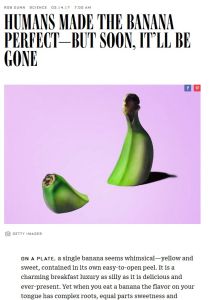
Rob Dunn
Humans Made the Banana Perfect – But Soon, It’ll Be Gone
Wired, 2017
What's inside?
The banana can teach you about the precarious state of today’s food supply.
Recommendation
The modern food industry has nearly perfected agriculture: Most fruits are available all year round; staple foods look the same and taste the same wherever you go; and crop yields are so high that fewer and fewer people go hungry every year. But what made modern agriculture so successful may also be the cause of its own destruction, says Rob Dunn, a professor of applied ecology who has written a book on the future of the world’s food supply. In this excerpt from his book, Dunn uses the banana as a case study to demonstrate that today’s staple food crops are only one pest away from being wiped out. getAbstract recommends this eye-opening information to all consumers.
Take-Aways
- The Cavendish banana is the only variety of the fruit available in stores outside traditional banana-growing regions. All Cavendish bananas are genetically identical.
- Plants that are genetically identical and planted close together in vast monocultures are susceptible to the same pathogens.
- A new pest has started to wipe out Cavendish banana plantations in Asia and East Africa. It is now also threatening the Cavendish in Central America.
- Today’s agriculture industry has standardized almost all commonly consumed, high-yield food crops into a small number of species that could all meet a similar fate.
- The world’s food supply depends on the availability of a variety of food crops from which scientists can develop new crop varieties resistant to the pathogens that wiped out previous varieties.
Summary
The United Fruit Company, known today as Chiquita Brands, has dominated the production and global sale of bananas for more than a century. In the 19th century, the company and its competitors bred and cloned the banana into one standard variety – a hardy, highly productive and sweet-tasting fruit named Gros Michel – and grew it across Central America and some parts of Africa and Asia. But by cultivating only one genetically identical banana variety, the banana industry failed to heed the lesson of the 19th-century coffee industry in Ceylon (now Sri Lanka). In the early 1800s, the British started to cultivate a single variety of coffee across large parts of the island to answer growing demand for the beverage at home. As the coffee plants were genetically identical and planted close together in vast monocultures, they were also susceptible to the same pathogens. Coffee rust ended up destroying the coffee plants in Ceylon, and coffee growers reverted to growing tea on their plantations.
“Any pathogen that could attack a single banana plant, even one, would be able to kill all of them.”
Similarly, Panama disease, or fusarium wilt, started to destroy Gros Michel banana plantations across Guatemala and the rest of the world by the early 1900s. The United Fruit Company scrambled to find a new variety of banana that was resistant to the pathogen and looked and tasted like the Gros Michel. The Cavendish banana met the criteria. A successful marketing campaign allowed the banana industry to boost worldwide sales of the Cavendish, which practically became the only variety of banana available in stores outside native banana-growing regions. Countries like Costa Rica, Ecuador, Panama and Belize, whose number one export item is the banana, came to depend strongly on the success of the crop. But a new strain of a pathogen closely related to the one that caused Panama disease has started to spread across Asia and East Africa. It is now also threatening banana plantations in Central America.
“The more we feed ourselves according to our most primitive desires, the more we create a world dominated by just a few productive crops – crops that are threatened by their very commonness.”
Today’s agriculture industry has standardized almost all commonly consumed, high-yield food crops into a small number of species that could all meet a similar fate. The only way banana growers were able to save the banana from extinction in the early 1900s was to find a new, disease-resistant variety among wild banana plants. Going forward, protecting biodiversity is thus the only way humans can preserve their food supply.
About the Author
Rob Dunn, a professor of applied ecology at North Carolina State University, wrote the book Never Out of Season.
This document is restricted to personal use only.
My Highlights
Did you like this summary?
Read the articleThis summary has been shared with you by getAbstract.
We find, rate and summarize relevant knowledge to help people make better decisions in business and in their private lives.
Already a customer? Log in here.

















Comment on this summary